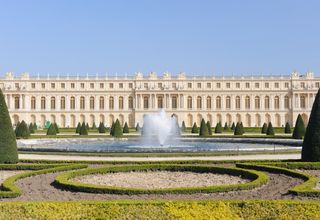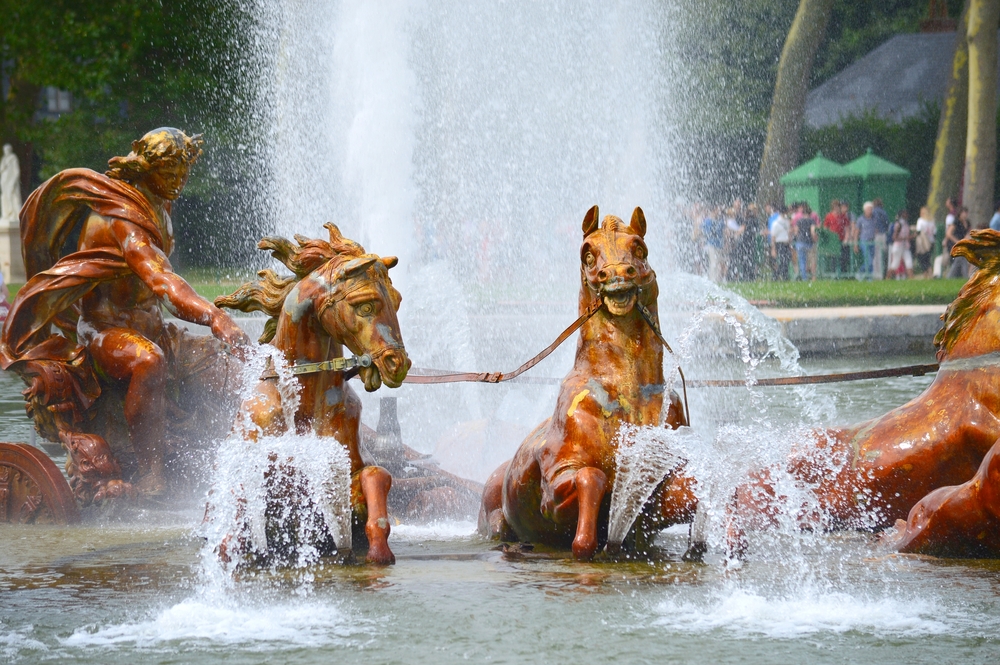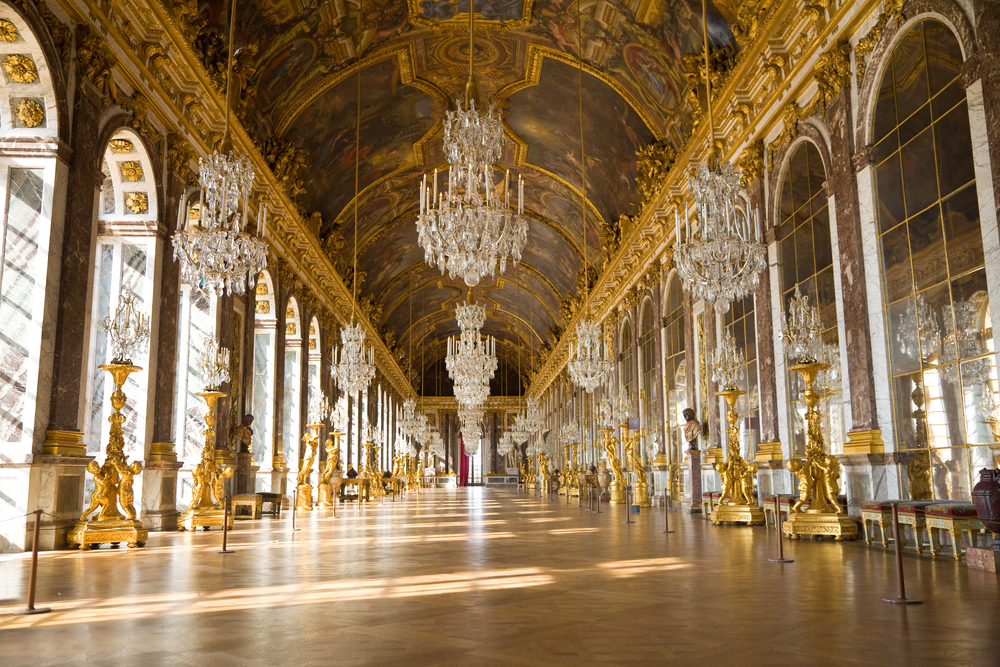What Message Does This Image Send to Other European Monarchs
Palace of Versailles: Facts & History

The Palace of Versailles is an opulent circuitous and former regal residence outside of Paris. Information technology has held sway in the public imagination for years because of its architectural grandeur and political history.
"To the public imagination, Versailles is the epitome of opulence," said Louise Boisen Schmidt, a Kingdom of denmark-based writer at This Is Versailles. "Information technology represents an historic period in French history of both France's rise equally a mode and power center as well as the dramatic — and encarmine — refuse of the monarchy."
Located almost 10 miles (16 kilometers) southwest of Paris, the palace is beside the settlement of Versailles. The boondocks was little more than than a hamlet before becoming the seat of royal power. Past the time of the French Revolution, it had a population of more than 60,000 people, making information technology one of the largest urban centers in French republic.
From hunting lodge to palace
French republic'south kings were first attracted to Versailles because of the expanse's prolific game. Louis XIII, who lived 1601-1643, bought up land, built a chateau and went on hunting trips. At the fourth dimension, much of the land around Versailles was uncultivated, assuasive wild animals to flourish.
The chateau Louis Xiii built was little more than a hunting lodge having enough space to house the king and a small entourage. It was his successor, Louis 14 (1638-1715), the "Sun Rex," a ruler who chose the sun as his keepsake and believed in centralized government with the male monarch at its heart, who would radically transform Versailles making information technology the seat of French republic's regime by the fourth dimension of his death.

Louis XIV ruled France for 72 years, and in that fourth dimension transformed Versailles past encompassing Louis 13's chateau with a palace that contained due north and south wings, too as nearby buildings housing ministries.
Versailles was built to print. "The most of import message Louis XIV sent through the architecture of Versailles was his ultimate power," said Tea Gudek Snajdar, an Amsterdam-based art historian, museum docent and a blogger at Culture Tourist. "He is an accented monarch, untouchable and afar. Just, even more and then that, he is the Sun Rex. That symbolism of the Sunday King is very visible in the architecture of the Versailles. The painter Lebrun, who designed the iconographic program of the Palace, focused paintings, sculptures and the architecture to one goal only — jubilant the Male monarch."
A serial of gardens, created in a formal mode, stood to the west of the palace (one of them today is in the shape of a star) and contained sculptures likewise as the pressurized fountains capable of launching h2o high into the air. The formality and grandeur of the gardens symbolized Louis Fourteen'due south absolute power, even over nature, according to Gudek Snajder.
"From the outset Louis attached a supreme importance to these water effects. Their virtuosity formed the star turn of a tour of the gardens," writes Tony Spawforth, a professor at Newcastle University, in his book "Versailles: A Biography of a Palace" (St. Martin'southward Press, 2008). "The effects were the work of engineers whose machines made Versailles a hydraulic as much as an artistic wonder." Unfortunately, Spawforth notes, bug supplying h2o meant that the fountains could but be turned on during special occasions.
In addition a 1000 canal, synthetic to the west of the garden and running about a mile long, was used for naval demonstrations and had gondolas, donated by the Republic of Venice, steered by gondoliers.
Edifice such a lavish circuitous was an of import part of Louis 14's style of rule and beliefs about monarchy, which nosotros would call absolutism, said Schmidt. "As king of France he was the embodiment of France — and his palace was meant to display the wealth and power of his nation," she said. "Furthermore, information technology was vital to him to heighten France's status in Europe; not merely by military feats but in the arts likewise. For instance, when the Hall of Mirrors was built, mirrors were unremarkably imported from Italy at a great cost. Louis Fourteen wanted to show that France could produce mirrors only as fine every bit those produced in Italy, and consequently, all the mirrors of that hall were made on French soil."
Louis as well insisted on moving the French government to Versailles. Scholars have suggested a number of factors that led him to build a bang-up palace complex at Versailles and motion the French government there. It's been noted that by keeping the king'due south residence some distance from Paris, it offered him protection from whatever ceremonious unrest going on in the city. It also forced the nobles to travel to Versailles and seek lodging in the palace, something that impeded their ability to build upwardly regional power bases that could potentially challenge the king.
Equally the French regime moved into Versailles, and the king plant himself swamped past work in his palace, he built himself the Thousand (too called Marble) Trianon, a more modest palatial structure, about a mile (1.6 kilometers) to the northwest of the palace as a private retreat where only he and those invited could visit.
Inside the palace
Spawforth notes that the palace independent about 350 living units varying in size, from multi-room apartments to spaces near the size of an alcove. The size and location of the room a person got depended on their rank and continuing with the male monarch. While the crown prince (known as the dauphin) got a sprawling apartment on the basis flooring, a servant may have aught more than a space in an attic or a makeshift room backside a staircase.
Louis XIV'south bedroom was built on the upper floor and located centrally forth the east-west axis of the palace. It was the most important room and was the location of ii important ceremonies where the king would wake up (lever) and go to sleep (coucher) surrounded by his courtiers. The king also had a ceremony for putting on and taking off his hunting boots.

These practices were symbols of Louis XIV'due south moniker of Sun Male monarch. "His courtroom was seen as microcosms of the universe and the king is the dominicus that shines over everything. Each action he would took (having a meal, strolling through the garden) became symbolic metaphor for his divine presence," explained Gudek Snajdar. "The 'Escalier des Ambassadeurs' was the first and the almost of import Baroque ceremonial staircase. The interaction between the visitor and the male monarch could exist directed hither in the most careful fashion."
The importance of the courtiers' presence at these ceremonies continued into the reigns of Louis XV and Sixteen. Spawforth notes that a courtier in 1784 wrote that "virtually of the people who come to the court are persuaded that, to make their way in that location, they must testify themselves everywhere, be absent as picayune possible at the king'south lever, removal of the boots, and coucher, testify themselves assiduously at the dinners of the royal family ... in short, must ceaselessly piece of work at having themselves noticed."
The rex had his throne in the "Apollo Salon" and worshiped in a imperial chapel, which spanned two stories, which Bajou notes was built between 1699 and 1710.
Despite the richness of the palace, the kings had to brand do with makeshift theaters up until 1768 when Louis Xv immune the building of the royal opera. It contained a mechanism that allowed the orchestra level to be raised to the stage assuasive it to be used for dancing and banqueting. Spawforth notes that the opera required three,000 candles to be burned for opening night and was rarely used due to its cost and the poor shape of France'due south finances.
Art and architecture
According to Schmidt, to our modern optics, Versailles is a perfect example of bizarre and rococo architecture. But, said Gudek Snajdar, the French of the time would not have considered information technology baroque. "And it'south understandable why," she said. "It'southward very dissimilar from, for example, Italian baroque compages, which served as an inspiration for other European countries during that time."
Having his palace evoke Italian baroque architecture would have angered Louis 14. It would accept gone confronting his sense of absolutism, said Gudek Snajdar, the belief that he is at the center of everything. In fact, Louis XIV fired a famous Italian architect hired to work on the Louvre Palace, which was built non long before Versailles.
Some art historians now call the style of the Louvre and Versailles "French classicism." They possess somewhat different features than Italian baroque compages, including the accent on symbols of power and timeless domination. Other types of bizarre architecture featured symbolic art, just not necessarily with the emphasis on divine right, kingly power and timeless rule.
"Everything in the Versailles of Louis XIV had a symbolic pregnant," said Schmidt. "The ceilings are adorned with illustrations of Roman gods with Louis XIV himself painted equally Apollo, the Sun God. Throughout the palace you will detect the intertwined L'southward of his proper name. It all serves equally a constant reminder that he is the king and all power comes from him by the grace of God."
The decoration likewise emphasized the achievements of the king. "The 'Hall of Mirrors' and the adjacent Salons of War and Peace were decorated with the history of the male monarch," said Gudek Snajdar. The Hall of Mirrors has 30 tableaux that depict an epic story of Louis XIV'due south achievements and aspirations. Victory in boxing features prominently in these narratives, with ane example showing Louis with his army crossing the Rhine River in 1672. He is dressed in Roman clothes, his long hair flows backside him, and he holds a thunderbolt like a projectile. He sits like a god in a chariot that is being pushed by none other than Hercules himself.
Estate of Marie Antoinette
Near the Grand Trianon, Marie Antoinette, the queen of Louis XVI, created an estate for herself. She took over a building called the "Petit Trianon" and congenital a number of structures, including a working subcontract (besides called the "village"), which provided the palace with fresh produce, and a nearby firm and small theater.
She also congenital a "Temple of Beloved," which modern-solar day curators say can be seen from her room in the Petit Trianon. Information technology features a dome propped up by nearly a dozen columns roofing a statue, which shows a depiction of "Cupid cutting his bow from the lodge of Hercules," Bajou writes.
Additionally, she built the charming "grotto," a cave that had a moss bed for Marie Antoinette to lie on. It had 2 entrances, prompting much speculation equally to what went on in it.
Though Marie Antoinette is known for her lavishness, in reality she did not always savor existence queen. Her estate reflects a want for a simpler life and homesickness for her native Austria. "Marie Antoinette grew up in Vienna equally the youngest daughter of Empress Maria Theresa and Francis I. In the Habsburg Empire, royalty was allotted a far greater sense of privacy and she had a remarkably "normal" upbringing," explained Schmidt. "During her childhood she would enjoy private family dinners and played with commoners' children, but at Versailles that was impossible. Once she had go Dauphine, her life was constantly in the spotlight. Etiquette demanded that she dine before a seemingly never-catastrophe crowd of spectators and getting dressed was a court ceremony in itself."
Marie Antoinette attempted to suspension some etiquette rules but was opposed by the court and the French people. She built the Hamlet and took over the Petit Trianon so that she could escape the many watchful optics and exist herself. Information technology was an attempt to "recreate some of her dearly missed childhood."
American history at Versailles
Two key events in the American Revolution happened at Versailles. Benjamin Franklin, acting on behalf of a newly independent United states of america, negotiated a treaty with Louis Sixteen, which led to America getting critical support from the French military. Spawforth notes that Louis XVI would take i of his inventions, a "Franklin chimney," installed that produced less smoke than an ordinary fireplace.
Fittingly, the Treaty of Paris, which formally ended the Revolutionary War, was signed on Sept. 3, 1783, at Versailles, close to the palace in the nearby strange affairs building. Several decades later, when King Louis Philippe (reign 1830-1848) was turning Versailles into a museum, he would include a painting that depicts the siege of Yorktown, a decisive victory in the Revolutionary War in which the Americans and French cooperated against the British.
America would reciprocate in the 1920s when oil millionaire John D. Rockefeller Jr. paid to have the palace'southward expansive roof restored, among other buildings.
Versailles after the autumn
Afterward the outbreak of the French Revolution in 1789, King Louis XVI and Queen Marie Antoinette would be stripped of power, brought to Paris and ultimately beheaded. The palace savage under the control of the new republican government.
Many of its effects were sold to help pay for the subsequent Revolutionary Wars. When Napoleon came to ability, he had an apartment created for himself in the M Trianon, complete with a map room.
King Louis Philippe, in the museum he created, showcased different aspects of French history. The Battles Gallery tin can still be seen today with its modern-mean solar day keepers noting that the gallery's art depicts every main French battle between the Battle of Tolbiac in A.D. 496 and the Battle of Wagram in 1809.
In the late 19th and 20th centuries, Versailles curators would convert many of the museum areas dorsum into palace space, trying to prove how they looked before the French Revolution.
Two more pivotal events would occur at Versailles in this mail-revolutionary menses. In 1871, after France had lost a state of war against Prussia, Kaiser Wilhelm I was proclaimed Emperor of Germany in the Hall of Mirrors, calculation an extra layer of humiliation to the French defeat. For several years after this defeat, the situation in France was and then bad that its Chamber of Deputies and Senate opted to encounter at Versailles, rather than Paris, for reasons of prophylactic.
In 1919, French republic would have its revenge, of sorts, when the Treaty of Versailles, which imposed reparations on Federal republic of germany, was signed in the same hall. Although the treaty formally concluded World War I, information technology has been argued by some that it helped pave the manner for Globe War 2. Even and so, centuries after its modest start as a hunting social club, events still took place at Versailles that ultimately helped shaped the world we live in today.
Legacy
Today, Versailles is ane of the most-visited sites in France. Visitors are drawn to its architectural grandeur, the stunning water features (concerts are oft played in the gardens during the summer) and its sense of history.
Every bit a symbol, Versailles can exist understood as ane of opposites, said Schmidt. It reflects both the beauty and culture of France and its tumultuous history. "When it was built, it was a marvel (and nevertheless is) and represented French republic's power. Withal, toward the terminate of the 18th century it became more of a symbol of the aristocracy's wealth, which stood in stark contrast to that of the common people. The entire mindset of society had changed with the Enlightenment, which acquired the palace to be seen as a symbol of the old regime."
Source: https://www.livescience.com/38903-palace-of-versailles-facts-history.html

Belum ada Komentar untuk "What Message Does This Image Send to Other European Monarchs"
Posting Komentar